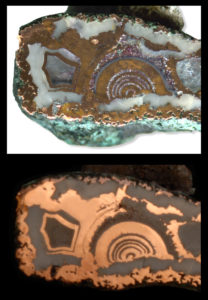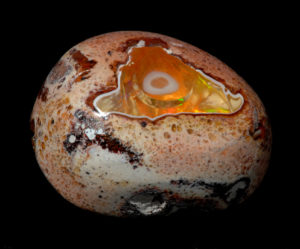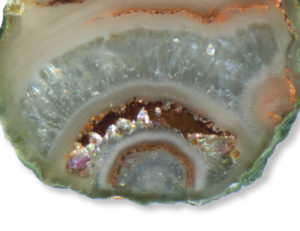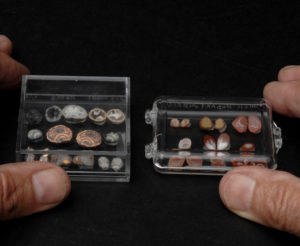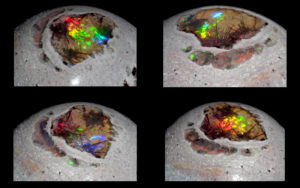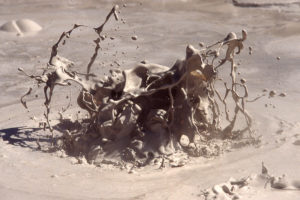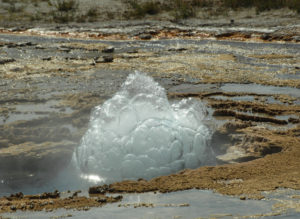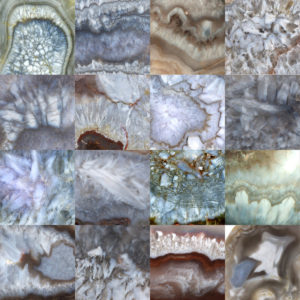Recently I noticed a copper agate eye posted by Cory Just. It looked eerily familiar to me. Here is a scan and a photograph of my version. More images are at www.mudpot.com. I have written two books filled with pictures like these: Lake Superior Copper Agates and Copper Eye Agates.
My fascination with these opals comes from their complex patterns and endless variety. Here, the matrix and fire can be seen as reflections on a ribbon-like surface surrounding its central eye. These patterns probably formed in a manner similar to that for agates, since both consist of mineral precipitation within a fluid-filled cavity. About 80 pictures in the book Canteras, Mexican Opals in Matrix show agate features.
Variations in these agate patterns continually amaze me. Here, quartz crystals fill a thick copper band. The purple-red appears to be cuprite. This thick band appears dark when scanned, because a polished copper surface is only bright when photographed at a specific angle. Areas with tiny copper particles are always bright. That so many quartz crystals fill a single copper band is a puzzle.
Canteras are Mexican opals in matrix. Some have features similar to agates, probably because they also form within cavities in matrix. These pictures show how the fire varies with angle of view. This opal appears to have goethite-coated rutile crystals in it, but I’m a novice for crystal identification. Many pictures like this are shown in my book, Canteras, Mexican Opals in Matrix. Slideshows are also at www.mudpot.com .
Jack Hobart
Now that I’ve completed a bunch of books, its time to start sharing mudpot and geyser photos. This high speed mudpot burst shows hidden object patterns like those in Look! What’s that Lurking in the Mudpots?. Details are at www.mudpot.com . Do you see the hidden face in the image? The pictures span 40 years and locations around the world. I’m addicted to mud patterns of all sorts; splasher mudpots, mud bursts, mud volcanoes, mud geysers, explosion craters and swirling patterns in quiet pools. I hope to post more pictures to support discussions about mudpots.
Jack Hobart
I became fascinated with geysers that form blue bubbles at the start of their eruptions. These consist of a doming up of the water before turning to a normal geyser eruption. Botryoidal Spring became a geyser in 1996 when I first noticed its amazing bubble shapes. Using the same camera techniques as for mudpots, similar surface patterns were revealed. Here’s a more recent example taken a half second into the eruption. My new book, Unusual Geysers, is about these geysers. An animation of a similar eruption is shown at www.mudpot.com. Spanning two seconds, its water rises, creates a bubble. then turns to spray.
Jack Hobart
Skip an atom agates are an uncommon variety of Lake Superior agates. Closeups of their crystal patterns like these have been used to help determine how they are formed. Details are in my July 2017 Rock & Gem magazine article, my book Skip an Atom Agates and at www.mudpot.com. I can also share information from my large database of these unusual agates in response to any questions.
Jack Hobart
